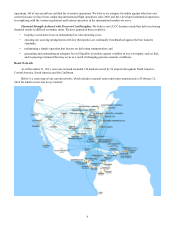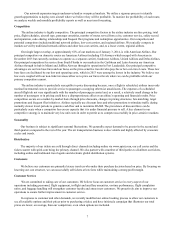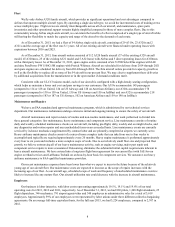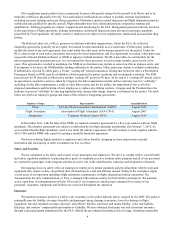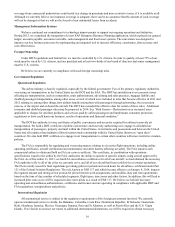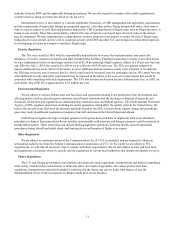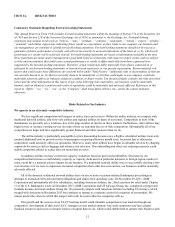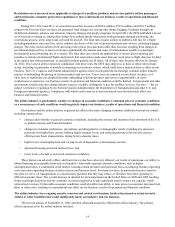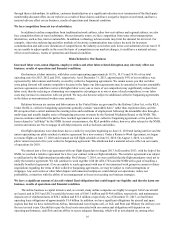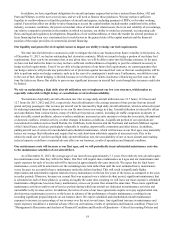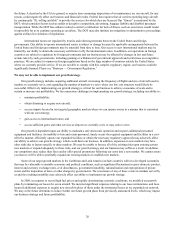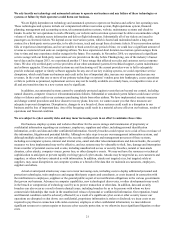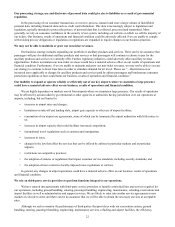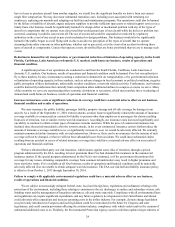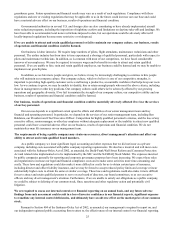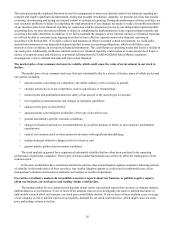Spirit Airlines 2013 Annual Report Download - page 16
Download and view the complete annual report
Please find page 16 of the 2013 Spirit Airlines annual report below. You can navigate through the pages in the report by either clicking on the pages listed below, or by using the keyword search tool below to find specific information within the annual report.16
through these relationships. In addition, customer dissatisfaction or a significant reduction in or termination of the third-party
membership discount offers on our website as a result of these claims could have a negative impact on our brand, and have a
material adverse effect on our business, results of operations and financial condition.
We face competition from air travel substitutes.
In addition to airline competition from traditional network airlines, other low-cost airlines and regional airlines, we also
face competition from air travel substitutes. On our domestic routes, we face competition from some other transportation
alternatives, such as bus, train or automobile. In addition, technology advancements may limit the demand for air travel. For
example, video teleconferencing and other methods of electronic communication may reduce the need for in-person
communication and add a new dimension of competition to the industry as travelers seek lower-cost substitutes for air travel. If
we are unable to adjust rapidly in the event the basis of competition in our markets changes, it could have a material adverse
effect on our business, results of operations and financial condition.
Risks Related to Our Business
Increased labor costs, union disputes, employee strikes and other labor-related disruption may adversely affect our
business, results of operations and financial conditions.
Our business is labor intensive, with labor costs representing approximately 19.1%, 19.1% and 19.6% of our total
operating costs for 2013, 2012 and 2011, respectively. As of December 31, 2013, approximately 59% of our workforce was
represented by labor unions and thereby covered by collective bargaining agreements. We cannot assure you that our labor
costs going forward will remain competitive because in the future our labor agreements may be amended or become amendable
and new agreements could have terms with higher labor costs; one or more of our competitors may significantly reduce their
labor costs, thereby reducing or eliminating our comparative advantages as to one or more of such competitors; or our labor
costs may increase in connection with our growth. We may also become subject to additional collective bargaining agreements
in the future as non-unionized workers may unionize.
Relations between air carriers and labor unions in the United States are governed by the Railway Labor Act, or the RLA.
Under the RLA, collective bargaining agreements generally contain “amendable dates” rather than expiration dates, and the
RLA requires that a carrier maintain the existing terms and conditions of employment following the amendable date through a
multi-stage and usually lengthy series of bargaining processes overseen by the National Mediation Board, or the NMB. This
process continues until either the parties have reached agreement on a new collective bargaining agreement, or the parties have
been released to “self-help” by the NMB. In most circumstances, the RLA prohibits strikes; however, after release by the NMB,
carriers and unions are free to engage in self-help measures such as lockouts and strikes.
Our flight operations were shut down due to a strike by our pilots beginning on June 12, 2010 and lasting until we and the
union representing our pilots reached a tentative agreement for a new contract. Under a Return to Work Agreement, we began
to resume flights on June 17, 2010 and resumed our full flight schedule on June 18, 2010. On August 1, 2010, we and the
pilots’ union executed a five-year collective bargaining agreement. This shutdown had a material adverse effect on our results
of operations for 2010.
We entered into a five-year agreement with our flight dispatchers in August 2013. In December 2013, with the help of the
NMB, we reached a tentative agreement for a five-year contract with our flight attendants. The tentative agreement was subject
to ratification by the flight attendant membership. On February 7, 2014, we were notified that the flight attendants voted not to
ratify the tentative agreement. We will continue to work together with the AFA-CWA and the NMB with a goal of reaching a
mutually beneficial agreement. If we are unable to reach agreement with any of our unionized work groups in current or future
negotiations regarding the terms of their collective bargaining agreements, we may be subject to work interruptions or
stoppages. Any such action or other labor dispute with unionized employees could disrupt our operations, reduce our
profitability, or interfere with the ability of our management to focus on executing our business strategies.
We have a significant amount of aircraft-related fixed obligations that could impair our liquidity and thereby harm our
business, results of operations and financial condition.
The airline business is capital intensive and, as a result, many airline companies are highly leveraged. All of our aircraft
are leased, and in 2013 and 2012 we paid the lessors rent of $166.3 million and $140.8 million, respectively, and maintenance
deposits net of reimbursements of $24.1 million and $31.6 million, respectively. As of December 31, 2013, we had future
operating lease obligations of approximately $1.4 billion. In addition, we have significant obligations for aircraft and spare
engines that that we have ordered from Airbus, International Aero Engines AG, or IAE, and Pratt and Whitney for delivery over
the next several years. Our ability to pay the fixed costs associated with our contractual obligations will depend on our
operating performance, cash flow and our ability to secure adequate financing, which will in turn depend on, among other


